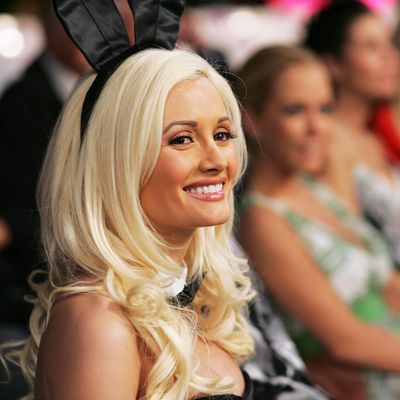
In the past couple of years, being a millennial woman has meant living in a state of perpetual vindication. I’m not talking about the “cancellation” of bad men but about our unfairly maligned pop-culture idols from childhood finally getting a chance to rewrite their stories and take control of their legacies. Look at the holy trinity alone: Britney Spears has been freed from an abusive conservatorship; Paris Hilton has become an activist, inspired by her inhumane treatment at a boarding school as a teen; and even Lindsay Lohan is finally making a return to acting.
But what about Holly Madison, the foundational “bimbo” icon and star of the reality show The Girls Next Door, who rarely gets her due? In Secrets of Playboy, the A&E docuseries that unearths the toxic culture behind the brand’s glossy exterior, we get reacquainted with Madison, Hugh Hefner’s No. 1 girlfriend from 2001 to 2008. She was the star of the influential early reality show on E! that captured the trials and tribulations of three young Bunnies living at the Playboy mansion by simultaneously making fun of them and sanitizing Playboy’s image. The giggling girls and their many small dogs could be seen rushing home from a birthday party in Vegas so they didn’t miss their 9 p.m. curfew and patriotically squeezing into military Bunny outfits for pictures to send to the troops. Though the women weren’t paid for the first season, the 2005 premiere episode got 990,000 viewers — double what was previously in the same slot.
On The Girls Next Door, Madison was the obedient and cheerful young blonde vying for far more than the title of Playmate of the Year. Even at 22, she was serious and wanted to marry Hef, have babies, and abolish his polyamorous lifestyle for good. But if you’ve been watching since — as her many fans on YouTube, TikTok and OnlyFans have — this documentary is but one of many times in which she’s revealed the truth about her time at the mansion. Though her social media now mainly focuses on her life as an influencer who loves makeup, Disney, and fashion, Madison has been talking about the psychological toll quaaludes, mandatory unprotected group sex, and crushing beauty standards took on her since long before Hef died in 2017.
“Around the turn of the millennium, it became fashionable for women to appear stupid — to get by solely on their looks and to be concerned only with fame and materialism. Some of the effects of that moment in the zeitgeist still linger today,” Madison said in the author’s note to her 2015 memoir, Down the Rabbit Hole: Curious Adventures and Cautionary Tales of a Former Playboy Bunny. “I felt like I had something to say about being in the midst of that whole thing that was going on where Paris Hilton and Jessica Simpson and Kendra [Wilkinson] were so celebrated — and I was a part of it, too — for being dumb on TV,” she told BuzzFeed. “Part of the reason I wanted to write the book was to show the other side of it.”
As was the case with the holy trinity, women like Madison were “celebrated” — they got rich off being perceived as hot and dumb — but the personal cost was being terrorized by a ruthless and abusive media that drove them to the point of insanity, addiction, or both. Drawing on a legacy established by Marilyn Monroe, who appeared on the cover of the first Playboy in 1953 without her consent, and furthered by Playmates turned bimbo superstars like Anna Nicole Smith and Pamela Anderson, the badge of bimbo has always seemed to come with a heavy dose of humiliation. In light of the new documentary, it’s clear The Girls Next Door essentially functioned as propaganda, one that relied on the whimsy and innocence of the bimbo aesthetic to cover up the dark realities of abuse. Hefner’s power lay in his ability to spin his predation into empowerment, to craft a narrative that his enterprise was about sexual liberation and changing sociosexual values, not exploiting young women.
As an avid Girls Next Door fan in high school, I was oblivious to the ridicule baked into the show’s premise and even saved up to buy a gold Playboy Bunny charm on a family vacation. In Madison’s ongoing YouTube series, in which she does a Girls Next Door rewatch, many commenters admit to feeling this same dissonance. One recalls being confused when she got in trouble for naming her hamster Holly and telling her mom it was “because of that TV show where three granddaughters live with their grandpa!” This deception was seemingly deliberate: “I feel like on The Girls Next Door, Hef was portrayed as like a kindly grandpa,” Madison says in Secrets of Playboy’s second episode. “But that’s not how he is. It would make me so angry how manipulative he was. He controlled every aspect of our life.” In the doc, Madison reveals she was afraid to leave what basically functioned as a cult, intimidated by a “mountain of revenge porn” Hef would threaten her with. (Hefner’s widow has since verified the existence of these pictures).
Despite all she’s been through, it’s refreshing to happen upon Madison’s cheerful TikToks now, which, despite occasionally referencing her time as a Bunny, feel divorced from Playboy’s exploitation. Even though she’s still a poster child for the brand’s signature look, it’s hard to know whether the army of 1.6 million who follow her on TikTok even know that. Madison’s content fits in seamlessly with videos made by influencers half her age, especially as her blonde, doe-eyed, big-lipped look seems to be back. She partakes in the filter du jour (“Which Powerpuff Girl are you?”) and identifies as a pickle girl, her image basically unchanged since she burst into the public spotlight 15 years ago.
Along with the liberation of Britney, Paris, and other early-aughts icons, their aesthetic (and the aughts more broadly) are trending. Gen-Z girls are wearing UGGs and low-rise jeans to our horror, but most interesting, some are embracing bimboism — but as a feminist act. Last year was called the Year of the Bimbo in part because the TikTok hashtag was filled with young women claiming bimbo status as one of empowerment; you simultaneously reap the rewards of being hot while not giving a shit if people perceive you as stupid.
As the identity has been reclaimed, it’s been stretched to become more inclusive. Many Gen-Z bimbos no longer identify with the original definition that mandates being blonde, thin, and having big boobs. In 2022, being a bimbo is more of … a vibe. As one popular self-proclaimed bimbo says, “Nobody can tell you how to be a bxmbo, because it isn’t about how people perceive you. The bxmbo has no gender, no class, no race or ability. The only requirement for bxmbofication is that you embrace and reclaim your body in the name of independence.”
Others have suggested that the return of the bimbo is a reaction to “the capitalist fever dream that was #girlboss feminism,” a way of leaning out and “refusing to participate.” As we trudge into year three of a pandemic that has particularly ravaged working women — sputtering on the fumes of the Me Too movement — we must admit relief and a bit of liberation in finally embracing “head empty.”
But for me, the respite of smooth brain doesn’t last long. As a millennial, it’s impossible to watch Secrets of Playboy — as well as the more popular new Hulu show Pam & Tommy — and not feel as though history is repeating itself. Even back then, as we abused and demonized its foremost icons, bimboism was framed as empowering. By trying to make the archetype fit neatly into the box of either “exploitative” or “feminist,” we obscure the messy reality that these dualities can both exist at the same time.
Thankfully, there are women like Holly Madison to remind us.




